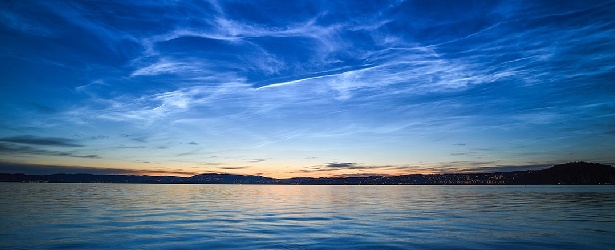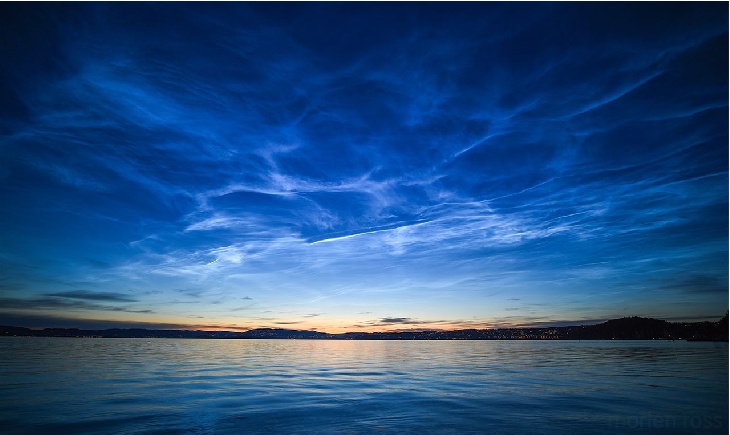Noctilucent clouds outburst reported

Sky watchers in Europe are reporting an outburst of bright noctilucent clouds (NLCs). The display began at sunset on July 3rd, filling northern horizons with electric-blue ripples, swirls, and tendrils of light.
Morten Ross sent this picture to SpaceWeather.com from Sandbukta, Norway:

Author Morten Ross on July 4, 2014 @ Sandbukta, south of Oslo, Norway. Image via SpaceWeather
"An incredibly bright and widespread display – from northern horizon to zenith!" says Ross. "This is only the third night of July and its already much better than last year." Similar reports have come from France, Germany, Poland, the Netherlands, Scotland, Ireland, England and Belgium.
Although most of the reports so far have come from Europe, the nights ahead could bring NLCs to North America as well.
More NLC images: SpaceWeather's Realtime NLC Photo Gallery
Noctilucent clouds
Night clouds or noctilucent clouds are tenuous cloud-like phenomena that are the "ragged edge" of a much brighter and pervasive polar cloud layer called polar mesospheric clouds in the upper atmosphere, visible in a deep twilight. They are made of crystals of water ice. Noctilucent roughly means night shining in Latin. They are most commonly observed in the summer months at latitudes between 50° and 70° north and south of the equator. They can only be observed when the Sun is below the horizon.
They are the highest clouds in Earth's atmosphere, located in the mesosphere at altitudes of around 76 to 85 kilometres (47 to 53 mi). They are normally too faint to be seen, and are visible only when illuminated by sunlight from below the horizon while the lower layers of the atmosphere are in the Earth's shadow. Noctilucent clouds are not fully understood and are a recently discovered meteorological phenomenon; there is no record of their observation before 1885.
Noctilucent clouds are first known to have been observed in 1885, two years after the 1883 eruption of Krakatoa. It remains unclear whether their appearance had anything to do with the volcano eruption, or whether their discovery was due to more people observing the spectacular sunsets caused by the volcanic debris in the atmosphere. Studies have shown that noctilucent clouds are not caused solely by volcanic activity, although dust and water vapour could be injected into the upper atmosphere by eruptions and contribute to their formation.
There is evidence that the relatively recent appearance of noctilucent clouds, and their gradual increase, may be linked to climate change. The author of this study, atmospheric scientist Gary Thomas of the Laboratory for Atmospheric and Space Physics at the University of Colorado has pointed out that the first sightings coincide with both Krakatoa and the nascent Industrial Revolution, and they have become more widespread and frequent throughout the twentieth century, including an uptick between 1964 and 1986.
Reference:
"Noctilucent clouds as possible indicators of global change in the mesosphere" – G.E. Thomasa, J. Oliverob – ScienceDirect – Elsevier – Advances in Space Research – DOI: 10.1016/S0273-1177(01)80021-1
Featured image: Author Morten Ross on July 4, 2014 @ Sandbukta, south of Oslo, Norway. Image via SpaceWeather

Commenting rules and guidelines
We value the thoughts and opinions of our readers and welcome healthy discussions on our website. In order to maintain a respectful and positive community, we ask that all commenters follow these rules:
We reserve the right to remove any comments that violate these rules. By commenting on our website, you agree to abide by these guidelines. Thank you for helping to create a positive and welcoming environment for all.